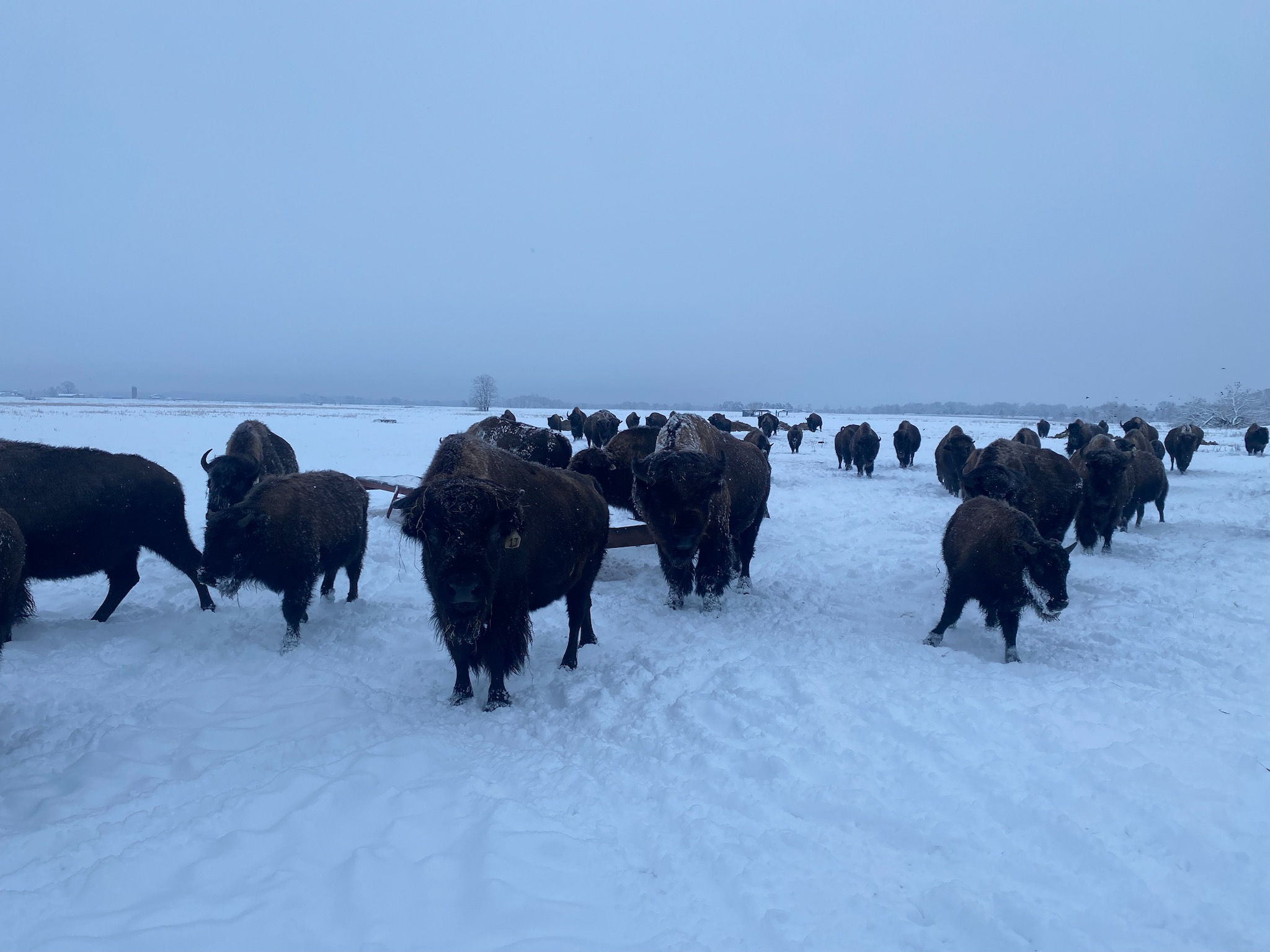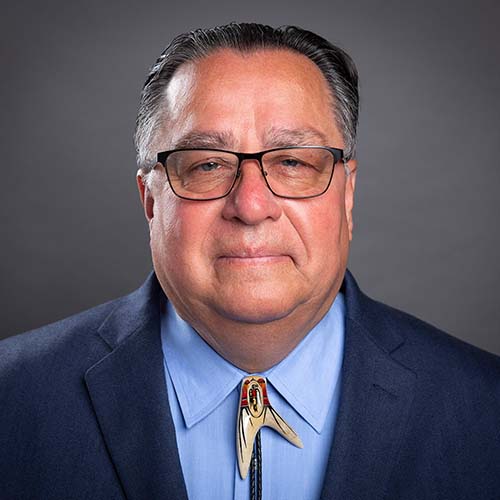
- Details
- By Chez Oxendine
Thanks to a growing Native-led movement to restore bison, tribes like the Modoc Nation in Oklahoma are seeing extraordinary results in 2025, the Nation now has more buffalo than tribal members.
The herd sits 500 strong, and three times a week ranch manager Jeremy Garrett spends the bulk of his day cycling between the sub-herds, checking on individual animals and ensuring the fences hold.
“I don't carry a card that says I'm a Native person, but my grandpa is, and buffalo have been an important animal to me - for me this is a dream come true,” Garrett said. “I get to share this passion with others through the work we do for the tribe.”
As federal priorities shift and its support slows for bison - but doesn’t stop - Native communities across the plains and western United States continue bringing the buffalo back from nigh-extinction to resume their central role in customs, foodways and ecosystems.
The Modoc maintain the herd both to support their own tribal members as well as those of nearby tribes who haven’t started their own ranches, Garrett said. Roughly 75 percent of the ranch’s annual 25,000 pounds go to these communities for free. Up until recently, that program was supported by a United States Department of Agriculture grant intended to put bison back into tribal diets. Now, the Modoc Nation has taken it over by offsetting costs with smaller federal and state grants, as well by selling some animals each year at farm shows.
“It’s tribes helping tribes,” Garrett said of the arrangement. “It’s a way for us to connect and support each other, while getting back to those traditional foods.”
In the late 1800s, the bison population in the United States had dwindled to just 12 in a small, federally-managed herd in Yellowstone Park. By the turn of the 20th century, Yellowstone’s once-thriving bison population had been decimated by relentless poaching, harsh winters, and habitat disruption. Scattered in remote, inaccessible terrain and hunted for trophies and meat, the “mountain buffalo” teetered on the brink of extinction. By 1896, just a dozen animals were spotted across the park - the last bastion of the buffalo in the country, as far as records show.
Now, amid a surging food sovereignty movement more than a hundred years later, tribes have not only become directly involved in bison revitalization, they’re often leading the way. Where federal support under a new administration might have lagged, tribes pick up the slack with new contracts, smaller grants, and product or animal sales while still funneling a crucial staple back into tribal diets through programs like the one run by the Modoc Nation.
It’s a similar story up in South Dakota, where the Cheyenne River Sioux Buffalo Corporation helms one of the biggest tribal herds in the country, at 2,500 head. In 2023, the ranch signed a purchasing contract with the USDA that paid $300,000 into providing buffalo meat for the Food Distribution Program on Indian Reservations.
Even after that contract expired in 2024, manager Jayme Murray said the ranch found other federal support to keep buffalo meat in distribution programs, as well as local schools. Murray estimated that under the new program, the ranch distributes between 10,000 and 12,000 pounds of meat a month, as well as securing local produce and fruit where they can.
In that way, USDA support for buffalo restoration and food sovereignty hasn’t slowed so much as it has changed this year, Murray said. A USDA representative confirmed that the agency maintained food sovereignty grants that targeted bison restoration efforts. A complete list of grant recipients is currently unavailable. The Food Distribution Program on Indian Reservations project was not renewed, programs for improving access to locally sourced foods were ongoing, and in some cases had expanded to include tribal producers.
“For the last nine months we've been rolling now, we've been distributing local foods out in our districts and our communities using a food procurement grant,” Murray told Native News Online. “It's shifted a bit, but we've still been able to get some support for our local food sovereignty movements.”
After years of losing access to a cultural cornerstone, now tribal citizens on many reservations can walk into mainstream grocery stores and buy buffalo products off the shelves.
“People are happy to have that availability and that connection again,” Murray said. “It’s rewarding - to renew that bond we have with buffalo and see people like our elders, who weren’t allowed to speak their own language in school, be able to have this part of their culture. That’s pretty powerful.”
Reconnecting and Rebuilding
The Yellowstone bison has served as a major source of buffalo for tribes across the country that start their own herds.
The U.S. Parks and Wildlife Service still takes donations from the herd on an annual basis, where it ships them typically to the Fort Peck Reservation. From there, the Intertribal Buffalo Council takes over, to ensure the animals reach any of their 80+ member tribes. Founded in 1992, the Council served as a flashpoint to reconnect tribes with buffalo. It’s created a central organization to acquire and distribute animals, as well as provide technical support and economic development assistance.
According to a report from Tribal Business News, the organization has transported over 20,000 buffalo to Indian Country since its inception in 1992. (For reference, as recently as 2024 there were roughly 25,000 buffalo on tribal lands, per another TBN report.)
Tribes like the Cherokee Nation, the Shoshone Bannock Tribe, and the Blackfeet Nation have connected with these buffalo to start their own herds. Dozens, hundreds, or even thousands of buffalo are now part of these tribes’ wildlife management plans. As those herds grow, tribes will have more and more access to a cornerstone of their heritage, the council’s vice president Jason Baldes said.
“The systematic removal of the buffalo from our diets resulted in the highest rates of diabetes, heart disease, and other health issues,” Baldes said in a 2022 report. “Getting it back into our lives, back into our bellies, on our dinner plates, is going to help to heal us from the inside.”
More Stories Like This
Trump signs law that revokes some limits on drilling in Alaska’s National Petroleum ReserveSouthern Sierra Miwuk Nation Gets 900-Acres ofLand Back
Chilkat Indian Village Tells New Palmer Mine Owners They Are “Not Welcome” in Chilkat Valley
Tribes, Coastal Group Ask Army Corps to Revoke Permit for Texas Export Terminal
Michigan Tribes Tell Supreme Court: Don’t Bail Out Enbridge
Help us defend tribal sovereignty.
At Native News Online, our mission is rooted in telling the stories that strengthen sovereignty and uplift Indigenous voices — not just at year’s end, but every single day.
Because of your generosity last year, we were able to keep our reporters on the ground in tribal communities, at national gatherings and in the halls of Congress — covering the issues that matter most to Indian Country: sovereignty, culture, education, health and economic opportunity.
That support sustained us through a tough year in 2025. Now, as we look to the year ahead, we need your help right now to ensure warrior journalism remains strong — reporting that defends tribal sovereignty, amplifies Native truth, and holds power accountable.
 The stakes couldn't be higher. Your support keeps Native voices heard, Native stories told and Native sovereignty defended.
The stakes couldn't be higher. Your support keeps Native voices heard, Native stories told and Native sovereignty defended.
Stand with Warrior Journalism today.
Levi Rickert (Potawatomi), Editor & Publisher

